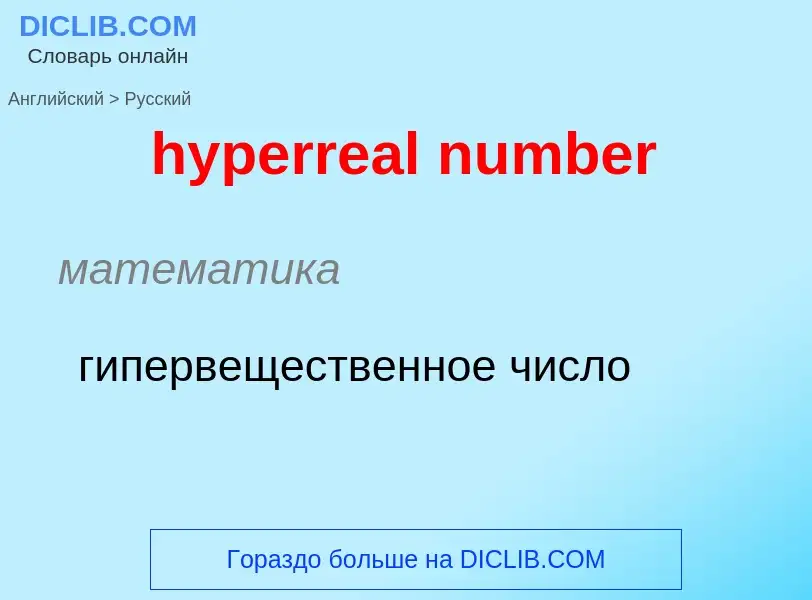Übersetzung und Analyse von Wörtern durch künstliche Intelligenz ChatGPT
Auf dieser Seite erhalten Sie eine detaillierte Analyse eines Wortes oder einer Phrase mithilfe der besten heute verfügbaren Technologie der künstlichen Intelligenz:
- wie das Wort verwendet wird
- Häufigkeit der Nutzung
- es wird häufiger in mündlicher oder schriftlicher Rede verwendet
- Wortübersetzungsoptionen
- Anwendungsbeispiele (mehrere Phrasen mit Übersetzung)
- Etymologie
hyperreal number - Übersetzung nach russisch
математика
гипервещественное число
математика
гипервещественное поле
Wikipedia

In mathematics, the system of hyperreal numbers is a way of treating infinite and infinitesimal (infinitely small but non-zero) quantities. The hyperreals, or nonstandard reals, *R, are an extension of the real numbers R that contains numbers greater than anything of the form
- (for any finite number of terms).
Such numbers are infinite, and their reciprocals are infinitesimals. The term "hyper-real" was introduced by Edwin Hewitt in 1948.
The hyperreal numbers satisfy the transfer principle, a rigorous version of Leibniz's heuristic law of continuity. The transfer principle states that true first-order statements about R are also valid in *R. For example, the commutative law of addition, x + y = y + x, holds for the hyperreals just as it does for the reals; since R is a real closed field, so is *R. Since for all integers n, one also has for all hyperintegers . The transfer principle for ultrapowers is a consequence of Łoś' theorem of 1955.
Concerns about the soundness of arguments involving infinitesimals date back to ancient Greek mathematics, with Archimedes replacing such proofs with ones using other techniques such as the method of exhaustion. In the 1960s, Abraham Robinson proved that the hyperreals were logically consistent if and only if the reals were. This put to rest the fear that any proof involving infinitesimals might be unsound, provided that they were manipulated according to the logical rules that Robinson delineated.
The application of hyperreal numbers and in particular the transfer principle to problems of analysis is called nonstandard analysis. One immediate application is the definition of the basic concepts of analysis such as the derivative and integral in a direct fashion, without passing via logical complications of multiple quantifiers. Thus, the derivative of f(x) becomes for an infinitesimal , where st(·) denotes the standard part function, which "rounds off" each finite hyperreal to the nearest real. Similarly, the integral is defined as the standard part of a suitable infinite sum.


![Russian chemist [[Dmitri Mendeleev]], creator of the periodic table. Russian chemist [[Dmitri Mendeleev]], creator of the periodic table.](https://commons.wikimedia.org/wiki/Special:FilePath/DIMendeleevCab.jpg?width=200)
![[[Henry Moseley]] in his lab. [[Henry Moseley]] in his lab.](https://commons.wikimedia.org/wiki/Special:FilePath/Henry Moseley.jpg?width=200)
![[[Niels Bohr]], creator of the [[Bohr model]]. [[Niels Bohr]], creator of the [[Bohr model]].](https://commons.wikimedia.org/wiki/Special:FilePath/Niels Bohr.jpg?width=200)
